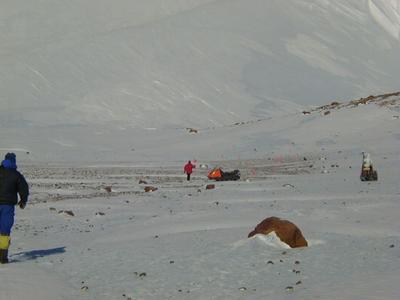7 January, 2003
Welcome Back
I just want to say welcome back to my students who are returning now from
winter break. You are all new students of mine this semester. Some of you
I know from previous classes and others I look forward to meeting. I
honestly feel badly for not being there to greet you on your first days of
Astronomy and Geology. Please be kind to Mr. Sheehan. He has the toughest
job in the world.
Most of you probably know a little bit about why I'm in Antarctica instead
of our classroom. To bring you up to date, I am sponsored by an
organization called TEA (Teachers Experiencing Antarctica and the Arctic)
who is part of the National Science Foundation. They match teachers and
researchers so that polar research can be transferred to the classroom. I
am also a member of a team called ANSMET (Antarctic Search for Meteorites).
This was started in 1976 and endeavors to return meteorite samples from
Antarctica for further study. Those of you that have taken my Astronomy
class know of my fondness for meteorites, so this was a perfect match. My
role on the team is to help find and collect meteorites, then transfer this
experience to my classes and the greater community. I've actually been
surprised by the support I've received here in the field. This website has
taken on a life of its own as both a TEA site meant for my students to see
and as an ANSMET site where friends, family, and enthusiasts can check up
on our daily activities. I have received lots of encouraging comments from
those monitoring the site back home.
I am one member of an eight person team that has been camping about 250
miles from the South Pole for the last five weeks. We have one week to go
until we are air lifted out to McMurdo Station, the main US Antarctic
Program Facility. Six of the eight are scientists who work closely with
meteorites. We also have a mountaineering guide who is an experienced
meteorite hunter and is mainly responsible for our safety. We have a
sister team that is doing reconnaissance work near the South Pole. They
are checking out unexplored ice fields to see if they are feasible
meteorite hunting grounds.
Now that you are up to date, let me tell you that it has been very cold
lately. This morning, the wind was still howling, and the temperature in
the tent was 14F. Usually the tents are at least 20 degrees warmer than
outside to give an idea of how cold it was. We're expecting a Twin Otter
tomorrow to help us with resupply and mainly to move some of our retro
(used, unwanted gear, and garbage) over to Beardmore Camp so that we don't
have to haul it. We used this morning to get our retro in order and ready
for the flight. By mid-afternoon the wind had died and it was much more
comfortable outside, so we went back to Quiche moraine to gather our flags
and take one last look around.
The wind had moved around some of the snow patches at Quiche and we wound
up finding 16 more meteorites, bringing our total to 460. 141 of those were
found at Quiche moraine alone. Many of us are very optimistic about our
chances at finding another 40 at the Mouthy Ice. Even though pizza, a
bath, and a bed sound very good right now, I don't want to leave without
breaking the 500 meteorite barrier! We finished the afternoon with an
after-hours excursion to check out some leaf fossils Scott discovered on a
moraine behind camp. We'll make a geologist of him yet.
Once again, to my students, welcome back. I'll be back in school by the
end of the month. I'll try to find time to shower before then.

A portion of the bamboo forest of flagpoles marking each meteorite found at Quiche Moraine.
Contact the TEA in the field at
.
If you cannot connect through your browser, copy the
TEA's e-mail address in the "To:" line of
your favorite e-mail package.
|
